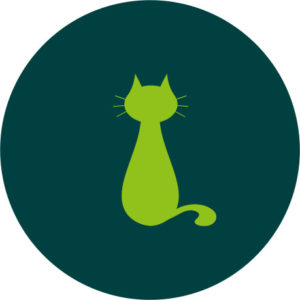
Cat age: 15 years or older
Human equivalent: 76 years or older
A generation ago, it was uncommon to see cats in the geriatric stage. If your cat lived past 10, they had ‘done well’ and we simply waited for nature to take its course. If your cat was fortunate (or unfortunate enough, depending on their health) to live to 15, it was expected that they would perhaps walk with a stiff gait, urinate on the floor, lose weight, go blind and howl loudly at night – that was simply part of growing old. The more we learn, however, the more we understand that these things are in fact NOT normal, they are all signs of illness that can be often be very effectively treated. Regular and frequent monitoring is incredibly important as health problems can develop quickly at this stage.
As more and more cats live into their geriatric years through better care in their younger years, it is now absolutely essential that owners have an awareness of their older cat’s health and wellbeing. There is so much that we can do now to keep geriatric cats comfortable, from keeping their blood pressure under control to keeping them well-hydrated to giving them the pain care that their elderly joints need. In fact, I will go so far as to say that almost all geriatric cats require some degree of medical attention at this stage of life, so if you think your cat is perfectly happy at 18, I would strongly urge you to look a bit closer.
Your cat probably won’t come out and ask you for help – you as their caregiver need to anticipate their needs and act accordingly. Not sure how to do that? Do your research as there are many things you can do at home to help, and then ring your vet to arrange a consultation. Not happy with the answer they give you or can’t bear the thought of taking your elderly cat into the clinic? Don’t give up, ask for a home visit or find someone else who can provide the type of care your cat needs as not all vets are experts in elderly cats. Getting your cat the care they need may not be easy, but that’s not an excuse – it is your responsibility to provide them with the happy, comfortable retirement they deserve.
Recommended Veterinary Care
| What needs to be done? | How often?* |
| Health check/physical exam | Every 3-6 months |
| Weight check | Every 3-6 months |
| Vaccination | Every 1-3 years according to individual risk assessment, if medical condition allows |
| Worming | Every 3-12 months as required by lifestyle |
| Flea treatment | Monthly, if you choose to treat, otherwise flea comb monthly |
| Nail trim | Check their nails every 3 months and trim as required |
| Blood pressure check | Every 3-6 months |
| Urine test | Every 3-6 months |
| Blood test | Every 6-12 months |
| Microchip | If your cat isn’t microchipped, consider having this done as older cats can be at increased risk or getting lost or being mistaken for a stray |
| Pet Insurance | If you have pet insurance, think very carefully before switching policies as previous treatment may exclude future coverage. Pet insurance at this age is likely very expensive, but this is also when you are most likely to use it. |
*Please note, recommendations may differ between vets and there isn’t necessarily a right or wrong answer, these are just our suggestions based on our desire to keep our cats safe but avoid over-treatment at the same time!
How You Can Help At Home
Be mindful of their ageing bodies
- As geriatric cats spend a large percentage of their day sleeping, make sure they have plenty of warm, soft places to lie down. Those with painful joints may prefer a heated bed, just be careful to cover the heat source with blankets to avoid burns. Their preferences may change with time so offer them a new option from time to time.
- Hiding places are essential for all cats but are especially important for older cats who may need to escape from the activity of a busy family life so make sure your cat has several easily accessible quiet, enclosed places where they can watch the world go by in peace and comfort.
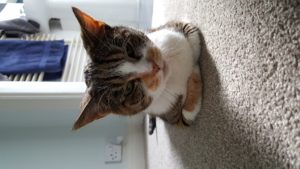
Give them a litter tray
- I cannot stress this enough – if your cat is in the geriatric stage, please please give them a litter tray indoors. Or more than one, preferably one on each floor or in each area of the house. Would you send your 90 year old grandmother out an awkward, elevated, spring-loaded door (to hit them on the backside as they try to exit) in the middle of the night to use a toilet at the back of the garden?
- Large trays with high sides will help avoid accidents but make sure there is a low area for them to enter without having to jump in which can be difficult on painful joints. Large plastic storage boxes with doors cut into them are a great DIY option or there are many different types available for purchase online.
Make their world as small as they need it to be
- This may sound a bit odd, but it is important to realise that cats naturally shrink their territories as they get older. A smaller area to patrol means fewer stressful interactions with neighbouring cats (even those in your own home), fewer steps to take on painful joints, less chance of forgetting where you left your dinner and greater odds of being able to find a toilet when you really need one.
- You can help your geriatric cat maintain their independence and dignity by keeping their core resources (food dish, water bowl, litter tray and sleeping areas) in a sensibly laid out (keep the food bowl away from the litter tray, etc) yet relatively small area.
Understand their need for consistency and predictability
- Geriatric cats are creatures of habit – they are generally less tolerant of new things and changes in routines can bring about stress. This is especially true for cats who may not be able to see or hear as well as they used to. It is particularly important to make sure that your cat’s core resources remain consistent if at all possible. Keeping to a regular time schedule can help as well. As far as the geriatric cat is concerned, if they recognise a particular item or event, it’s one less thing to worry about!
Pay very close attention to their fluid intake
- Maintaining hydration is critical at this stage, so take extra care to ensure plenty of fresh water bowls throughout the house. Offer several different options, such as pint glasses, ceramic bowls or water fountains, and place them strategically throughout the house, near sleeping areas and away from food if possible. Continue to add extra water to the wet food too. Make sure water dishes are filled to the brim as cats hate getting their whiskers wet! Raising food and water bowls off the floor by a few inches can ease the strain on a sore back and neck
- It’s very important that you let your vet know if your cat starts to drink or urinate more than they used to as this can be a sign of any number of underlying metabolic diseases such as kidney disease, hyperthyroidism or diabetes. Despite drinking more, these cats are actually usually dehydrated as they can never take in as much water as they need.
- Dehydrated cats have a tendency to become constipated, which you may notice as smaller, drier stools, not going as often or increased straining whilst defecating. Constipation can cause significant discomfort and distress, even if your cat just seems to get on with it. Encourage your older cat to drink as much as possible and if needed, speak with your vet about adding a bit of constipation medication to your cat’s food as this is usually well-tolerated and can make them much more comfortable.
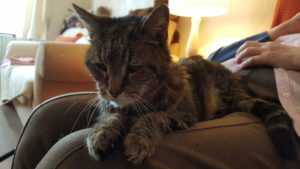
Assume your cat has at least one illness that you may not be able to see
- By the time they reach the geriatric stage, chances are your cat will have at least one, if not several, chronic health issues. The problem is they won’t tell you if they do. Regular examinations, blood, urine and blood pressure screening is therefore highly recommended as the earlier these conditions are caught, the easier they are to treat and the less of an impact they will have on your cat’s quality of life. No cat deserves to suffer in silence and even the grumpiest old cat can provide a urine sample at home or even a blood sample with a touch of light sedation so don’t give up, ask your vet about the most appropriate monitoring schedule for your cat.
- Just like in people, high blood pressure (hypertension) can be a silent killer in older cats. Not only can it give them a whopping headache, making them more vocal, more irritable and less likely to interact with their family or environment, but it can have serious effects on the heart, kidneys and other organs including the eyes, where it can cause blindness. High blood pressure can be caused by kidney disease, and can be related to hyperthyroidism and other diseases as well as being a medical condition in its own right. The older your cat is, the more likely they are to have high blood pressure and chances are you won’t be aware that your cat has hypertension until things go horribly wrong so it is important to have it checked regularly.
Look out for signs of joint pain
- It has been shown in recent years that between 60-90% of cats over 12 suffer from degenerative joint disease such as arthritis. Joint pain in elderly cats can be incredibly difficult to spot because they usually don’t limp or cry out in pain. In fact, detecting joint disease in your cat is more about what the DON’T do anymore than what they DO do.
- Does your cat hesitate before jumping up on or down from their favourite chair? Are they sleeping downstairs now when they used to regularly visit you upstairs in the bedroom? Do they prefer to use the litter tray rather than go out the cat flap into the garden to toilet? These are all signs of joint pain and shouldn’t be ignored.
- There are many options for treating painful joints, from liquids and tablets to acupuncture and heated beds to environmental modifications that make it easier for your older cat to live their life without stressing their ageing joints so if you think your cat may be in pain, please speak with your vet. If your vet says there is nothing you can do about it, get a second opinion.
- For more information, take a look at our articles on Pain Recognition and Pain Treatment.
Don’t forget about their teeth
- It may be easier not to think about that bad smell coming from your cat’s mouth, but ignoring the problem won’t make it go away. Regular dental checks are essential for geriatric cats as dental disease is unfortunately very common at this age. We all know how painful dental disease can be but it’s important to remember that cats rarely change their eating habits as a result of dental pain – it’s up to us to monitor their teeth and get them help when they need it.
- Although old age is not a reason to deny your cat any necessary dental treatment, it does increase the risk associated with anaesthesia so do not wait until things get worse to sort out a painful mouth, get your cat the treatment they need sooner rather than later. Despite the increased risk, it is still usually recommended that your cat’s dental disease be treated because you often don’t realise how much it is getting them down until you fix it. Even if dental treatment is not possible for one reason or another, pain care can be provided to keep them more comfortable despite their bad teeth.
Keep them active, both mentally and physically
- Even geriatric cats often like to play, but you may need to adapt the style of play to their ageing bodies so use your feather wand toy on the ground rather than up in the air, etc. Catnip is a great way to get even the most sedentary cat into a more active mood. Puzzle feeders are not only a good way to keep your cat active and slow down their meals but they’re good fun too.
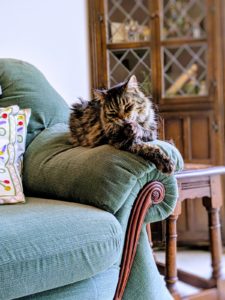
Help them groom
- Geriatric cats often struggle to groom themselves, resulting in a dull appearance or the development of small mats of fur as the loose hairs aren’t removed as effectively as before. Mild changes may be normal and you will probably have to help them maintain their coats with regular brushing (but be gentle over the spine or any painful joints) or perhaps adding a high quality essential fatty acid supplement to their food.
- Significant matting along their back, however, may indicate dental or back pain and a flaky coat could mean that their nutrition is inadequate so if your cat experiences more than mild changes in the quality of their coat, ask your vet for advice. If your cat is unable to clean themselves after eating or going to the toilet, help them maintain their dignity by using water-based baby wipes or a slightly moist flannel to wipe down their coats for them.
- Decreased grooming often also means that geriatric cats are no longer able to care for their nails. Claws can become thicker as they fail to shed, and can grow so long that they curl around and grow into the pads, a very painful condition that can mimic signs of arthritis. Your cat won’t tell you that their nails are too long so it’s important to check them regularly and give them a clip every 3-6 months. If you are unsure of how to do this yourself, ask your vet nurse for a demonstration or arrange for them to be clipped by the vet or groomer regularly.
- It can also help to provide horizontal scratching posts instead of vertical ones for older cats with sore joints – many older cats adore their cardboard scratch mats, especially with a bit of catnip, and can often be found napping on them as well.
Feed a high quality, varied diet
- Remember that cats, even geriatric cats, are strict carnivores – they are built to eat other animals or in other words, meat. Although most cats can tolerate grains and starchy foods to some extent, some cannot. Unless your vet has specifically recommended a particular diet for medical reasons, you are generally safe to feed your cat the highest meat content food you can afford and avoid foods with a lot of grains (carbs) or fillers (NOTE – ‘grain-free’ does not necessarily mean high in meat so check the ingredients list carefully).
- The one exception to this may be cats with kidney disease, although this is currently up for debate. Many vets recommend special ‘renal’ or kidney diets for cats with kidney disease and there is nothing wrong with this, especially for cats already on a standard higher carb diet, because they are clinically proven to help cats with the condition. For cats eating a high quality, low carb diet already however, it may make more sense to use readily available and palatable phosphate binders and omega-3 fatty acid supplements instead. There is no right or wrong answer here, not even the nutritionists agree, just make an informed decision and at the end of the day, go with the food your cat chooses to eat because it is far better for them to eat the ‘wrong’ food than not eat the ‘right’ food!
- Similarly, some food brands offer a ‘senior’ variety, for cats over 7 years old. While these may be appropriate for an overweight, inactive mature cat, they are not necessarily the right choice for an active cat or one who may be losing weight as they age. If the foods you feed your cat come in a senior variety then feel free to use them but don’t feel like you have to switch to a lower quality food just because it says ‘senior’ on the label. Many of the higher quality foods don’t need a senior version because their diets are more nutritious anyway and therefore suitable for all life stages.
- Because geriatric cats so commonly suffer from dehydration, wet foods are generally much better for them so back off on the biscuits if at all possible. Not only that, but try adding a few extra teaspoons of water to each meal to further increase the fluid intake.
- Even if they start to become fussy with their foods, try to make sure the majority of the food you feed your cat says it is ‘complete and balanced’, as feeding too many ‘complementary’ foods can result in dietary imbalances. Do your best to provide a high quality, balanced diet but for particularly fussy eaters, the best food for your geriatric cat is probably the one they will eat that day.
Good To Know
As cats enter their geriatric years, their bodies can start to show signs of wear and tear. Their coat can become dull and may change colour slightly, including the odd white hair. Their skin can become less elastic and more fragile so extra care is required when grooming. Their senses of hearing, sight, taste and smell can all become less acute with advancing age, affecting their behaviour and appetite. Memory and sleep may be affected, with some cats sleeping more deeply while others wake more at night. You may notice your cat appears more ‘fragile’ as ageing bones and muscles lose their strength, and a weaker immune system means they may find it harder to fight off infections. All of these natural ageing processes will result in minor changes in routines as they decide which activities are important to them in their advanced age. Be very careful when interpreting these changes, however, because many times by the time you notice a change, it is already beyond minor and may indicate a medical problem.
Although significant weight loss or muscle loss in senior cats is common, it is not normal and can be due to any number of conditions including chronic kidney disease, hyperthyroidism, diabetes, inflammatory bowel disease, cancer or arthritis. Similarly, a decrease in appetite or turning away from food may indicate nausea or other discomfort. If your geriatric cat is not eating well and/or losing weight, please bring this to the attention of your vet so the necessary diagnostic tests can be run. The sooner these conditions are diagnosed and treated, the more comfortable your cat will be.
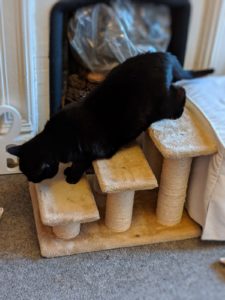
Another common myth about geriatric cats is that it is normal to ‘slow down’ or be ‘a bit stiff’ or sore. By the time cats reach the geriatric stage, nearly all have some degree of joint pain due to arthritis. In some cats this can be debilitating, resulting in visible signs of pain, however in many cats the changes are subtle enough that owners may not even notice them. Pain is never normal and treatment is often easier and safer than you may think. Some vets don’t realise this and may say there is nothing you can do about it – if this is the answer you are given, use the iCatCare website to find a more feline-friendly vet near you.
Hard, dry stools are NOT normal and should be brought to the attention of your vet as this is often a sign of other health problems.
Although stiffness and decreased mobility are not normal in older cats, an increase in the amount of time they spend sleeping can be normal in geriatric cats. It can be difficult, however, to distinguish a peaceful senior nap from a lack of mobility so if you have any concerns, please ask your vet for advice.
Geriatric cats may show less interest in the world around them, having learned not to panic at the sound of the doorbell or your neighbour’s dog barking, but they should still interact regularly with your family and their environment. If they become unaware that their food is being served or startle easily when approached, their hearing may not be as good as it used to be. Poor vision may result in decreased activity at night or hesitation when entering a room. Cognitive dysfunction, or feline dementia, can result in odd behavioural changes such as staring at walls and forgetting that you already gave them dinner. Urinary tract infections can mimic dementia and also cause inappropriate urination in the house. These changes are not normal so if you have any concerns about your cat’s behaviour, speak with your vet.
Geriatric cats often, for one reason or another, become more fussy with their food. Perhaps they feel unwell, or their senses of taste or smell are not as good as they used to be. They may happily eat one type of food one day, then turn their nose up at it the next. Don’t get angry or give up, simply put the rest of that variety in the cupboard and try again in a few weeks, chances are they’ll try it again later. Although it is normal for cats to prefer a varied diet, a change in your cat’s eating habits, particularly a decrease or increase in the amount of food that they eat in a day, may indicate a health problem so it’s worth bringing this to the attention of your vet.
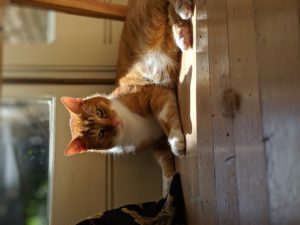
Although slight changes in vision (especially at night) can be normal for senior cats thanks to age-related clouding of the lenses, poor vision or blindness is not normal and in fact may be a sign that your cat has severe hypertension. Until about 10 years ago it was uncommon to regularly check older cats for high blood pressure so if you previously had an elderly cat go blind, there is a good chance that this was the cause.
Howling loudly at night is a common concern with older cats but again, this does not mean that it is normal. Crying out at night can be a sign of high blood pressure, deafness, hyperthyroidism, pain or cognitive dysfunction amongst other things so if your cat becomes more vocal as they age, have them checked by your vet.
This guide is based on the AAFP-AAHA Feline Life Stage Guidelines publication, as well as recommendations made by the ISFM CatCareforLife and iCatCare websites – please visit these highly informative websites for additional information.

